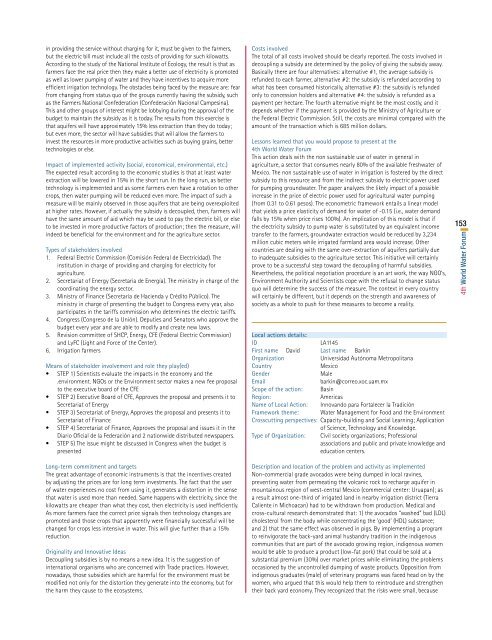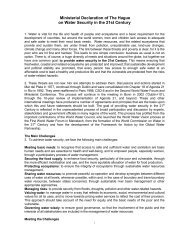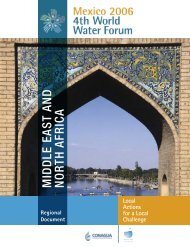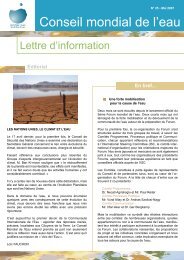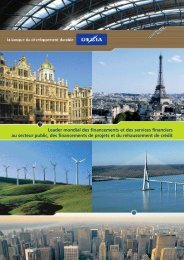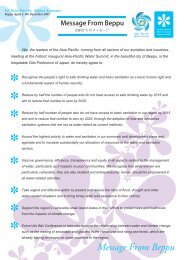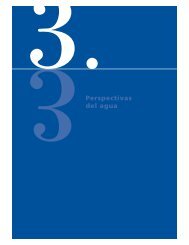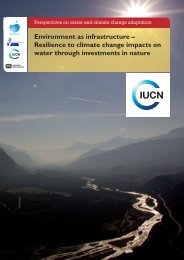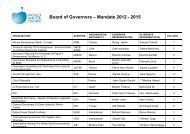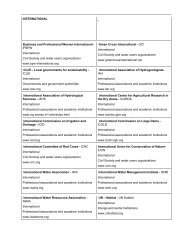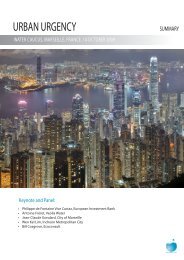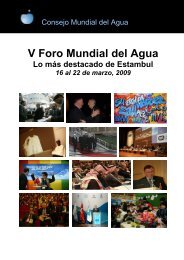Americas ok.indd - World Water Council
Americas ok.indd - World Water Council
Americas ok.indd - World Water Council
You also want an ePaper? Increase the reach of your titles
YUMPU automatically turns print PDFs into web optimized ePapers that Google loves.
in providing the service without charging for it, must be given to the farmers,but the electric bill must include all the costs of providing for such kilowatts.According to the study of the National Institute of Ecology, the result is that asfarmers face the real price then they make a better use of electricity is promotedas well as lower pumping of water and they have incentives to acquire moreefficient irrigation technology. The obstacles being faced by the measure are: fearfrom changing from status quo of the groups currently having the subsidy, suchas the Farmers National Confederation (Confederación Nacional Campesina).This and other groups of interest might be lobbying during the approval of thebudget to maintain the subsidy as it is today. The results from this exercise isthat aquifers will have approximately 15% less extraction than they do today;but even more, the sector will have subsidies that will allow the farmers toinvest the resources in more productive activities such as buying grains, bettertechnologies or else.Impact of implemented activity (social, economical, environmental, etc.)The expected result according to the economic studies is that at least waterextraction will be lowered in 15% in the short run. In the long run, as bettertechnology is implemented and as some farmers even have a rotation to othercrops, then water pumping will be reduced even more. The impact of such ameasure will be mainly observed in those aquifers that are being overexploitedat higher rates. However, if actually the subsidy is decoupled, then, farmers willhave the same amount of aid which may be used to pay the electric bill, or elseto be invested in more productive factors of production; then the measure, willindeed be beneficial for the environment and for the agriculture sector.Types of stakeholders involved1. Federal Electric Commission (Comisión Federal de Electricidad). Theinstitution in charge of providing and charging for electricity foragriculture.2. Secretariat of Energy (Secretaría de Energía). The ministry in charge of thecoordinating the energy sector.3. Ministry of Finance (Secretaría de Hacienda y Crédito Público). Theministry in charge of presenting the budget to Congress every year, alsoparticipates in the tariffs commission who determines the electric tariffs.4. Congress (Congreso de la Unión). Deputies and Senators who approve thebudget every year and are able to modify and create new laws.5. Revision committee of SHCP, Energy, CFE (Federal Electric Commission)and LyFC (Light and Force of the Center).6. Irrigation farmersMeans of stakeholder involvement and role they play(ed)• STEP 1) Scientists evaluate the impacts in the economy and the.environment. NGOs or the Environment sector makes a new fee proposalto the executive board of the CFE• STEP 2) Executive Board of CFE, Approves the proposal and presents it toSecretariat of Energy• STEP 3) Secretariat of Energy, Approves the proposal and presents it toSecretariat of Finance• STEP 4) Secretariat of Finance, Approves the proposal and issues it in theDiario Oficial de la Federación and 2 nationwide distributed newspapers.• STEP 5) The issue might be discussed in Congress when the budget ispresentedCosts involvedThe total of all costs involved should be clearly reported. The costs involved indecoupling a subsidy are determined by the policy of giving the subsidy away.Basically there are four alternatives: alternative #1, the average subsidy isrefunded to each farmer, alternative #2: the subsidy is refunded according towhat has been consumed historically, alternative #3: the subsidy is refundedonly to concession holders and alternative #4: the subsidy is refunded as apayment per hectare. The fourth alternative might be the most costly, and itdepends whether if the payment is provided by the Ministry of Agriculture orthe Federal Electric Commission. Still, the costs are minimal compared with theamount of the transaction which is 685 million dollars.Lessons learned that you would propose to present at the4th <strong>World</strong> <strong>Water</strong> ForumThis action deals with the non sustainable use of water in general inagriculture, a sector that consumes nearly 80% of the available freshwater ofMexico. The non sustainable use of water in irrigation is fostered by the directsubsidy to this resource and from the indirect subsidy to electric power usedfor pumping groundwater. The paper analyzes the likely impact of a possibleincrease in the price of electric power used for agricultural water pumping(from 0.31 to 0.61 pesos). The econometric framework entails a linear modelthat yields a price elasticity of demand for water of -0.15 (i.e., water demandfalls by 15% when price rises 100%). An implication of this model is that ifthe electricity subsidy to pump water is substituted by an equivalent incometransfer to the farmers, groundwater extraction would be reduced by 3,234million cubic meters while irrigated farmland area would increase. Othercountries are dealing with the same over-extraction of aquifers partially dueto inadequate subsidies to the agriculture sector. This initiative will certainlyprove to be a successful step toward the decoupling of harmful subsidies.Nevertheless, the political negotiation procedure is an art work, the way NGO’s,Environment Authority and Scientists cope with the refusal to change statusquo will determine the success of the measure. The context in every countrywill certainly be different, but it depends on the strength and awareness ofsociety as a whole to push for these measures to become a reality.Local actions details:IDLA1145First name David Last name BarkinOrganizationUniversidad Autónoma MetropolitanaCountryMexicoGenderMaleEmailbarkin@correo.xoc.uam.mxScope of the action: BasinRegion:<strong>Americas</strong>Name of Local Action: Innovando para Fortalecer la TradiciónFramework theme: <strong>Water</strong> Management for Food and the EnvironmentCrosscutting perspectives: Capacity-building and Social Learning; Applicationof Science, Technology and Knowledge.Type of Organization: Civil society organizations; Professionalassociations and public and private knowledge andeducation centers.1534th <strong>World</strong> <strong>Water</strong> ForumLong-term commitment and targetsThe great advantage of economic instruments is that the incentives createdby adjusting the prices are for long term investments. The fact that the userof water experiences no cost from using it, generates a distortion in the sensethat water is used more than needed. Same happens with electricity, since thekilowatts are cheaper than what they cost, then electricity is used inefficiently.As more farmers face the correct price signals then technology changes arepromoted and those crops that apparently were financially successful will bechanged for crops less intensive in water. This will give further than a 15%reduction.Originality and Innovative IdeasDecoupling subsidies is by no means a new idea. It is the suggestion ofinternational organisms who are concerned with Trade practices. However,nowadays, those subsidies which are harmful for the environment must bemodified not only for the distortion they generate into the economy, but forthe harm they cause to the ecosystems.Description and location of the problem and activity as implementedNon-commercial grade avocados were being dumped in local ravines,preventing water from permeating the volcanic rock to recharge aquifer inmountainous region of west-central Mexico (commercial center: Uruapan); asa result almost one-third of irrigated land in nearby irrigation district (TierraCaliente in Michoacan) had to be withdrawn from production. Medical andcross-cultural research demonstrated that: 1) the avocados “washed” bad (LDL)cholesterol from the body while concentrating the ‘good’ (HDL) substance;and 2) that the same effect was observed in pigs. By implementing a programto reinvigorate the back-yard animal husbandry tradition in the indigenouscommunities that are part of the avocado growing region, indigenous womenwould be able to produce a product (low-fat pork) that could be sold at asubstantial premium (30%) over market prices while eliminating the problemsoccasioned by the uncontrolled dumping of waste products. Opposition fromindigenous graduates (male) of veterinary programs was faced head on by thewomen, who argued that this would help them to reintroduce and strengthentheir back yard economy. They recognized that the risks were small, because


